Bangladesh Armed Forces
| Bangladesh Armed Forces | |
|---|---|
|
বাংলাদেশ সশস্ত্র বাহিনী Bānlādēśa saśastra bāhinī | |
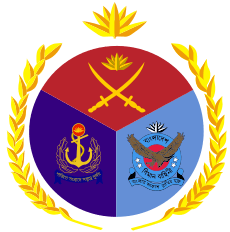 Tri-service Logo of Bangladesh Armed Forces. | |
 Flag of the Bangladesh Armed Forces | |
| Motto |
"চির উন্নত মম শির" (de facto) "Ever High is My Head" |
| Founded |
|
| Current form | 12 January 1972 |
| Service branches |
|
| Headquarters | Dhaka Cantonment |
| Leadership | |
| Commander-in-Chief | President Abdul Hamid |
| Leader of Armed Forces Division and Minister of Defence | Prime Minister Sheikh Hasina |
| Principal Staff Officer | Md Mahfuzur Rahman |
| Manpower | |
| Conscription | No |
| Available for military service | 36,520,491, age 19–49 (2010 est.) |
| Fit for military service |
30,486,086 males, age 19–49 (2010 est.), 35,616,093 females, age 19–49 (2010 est.) |
| Reaching military age annually |
1,606,963 males (2010 est.), 1,689,442 females (2010 est.) |
| Active personnel | 204,596[1] |
| Reserve personnel | 963,900[2] |
| Deployed personnel | 39,380[3] |
| Expenditures | |
| Budget | $3.45 billion (Not including Paramilitary Forces) (2018-19)[4][5] |
| Percent of GDP | 1.20% (2018-19) |
| Industry | |
| Domestic suppliers |
Bangladesh Machine Tools Factory Bangladesh Ordnance Factories Bangabandhu Aeronautical Centre Khulna Shipyard Dockyard and Engineering Works Limited |
| Foreign suppliers |
|
| Related articles | |
| History |
Bangladesh War of Independence Chittagong Hill Tracts Insurgency Gulf War Saudi Led Coalition against ISIL |
| Ranks | Military ranks of Bangladesh |

The Bangladesh Armed Forces (Bengali: বাংলাদেশ সশস্ত্র বাহিনী, Bānlādēśa saśastra bāhinī) consists of the three uniformed military services: the Bangladesh Army, the Bangladesh Navy and the Bangladesh Air Force. The para-military organization Bangladesh National Cadet Corps (BNCC) is a reserved force and directed by Army, Navy, Air Force. It is under the command of Defence Ministry. The para-military Border Guard Bangladesh (formerly Bangladesh Rifles) and Bangladesh Coast Guard are under the jurisdiction of the Ministry of Home Affairs[6] during peacetime, but during wartime they fall under the command of Bangladesh Army and Bangladesh Navy respectively.
The President of Bangladesh is the Commander-in-chief of the military, the Armed Forces Division (AFD) is the principal administrative organization by which military policy is formulated and executed and the Ministry of Defence (MoD) does not exercise any authority over the Armed Forces and is far less powerful than the AFD. Currently, both AFD and MoD are headed by the Prime Minister of Bangladesh. To coordinate military policy with diplomacy both the President and the Prime Minister are advised by a six-member advisory board, three Chiefs of Staff, which includes the head of each of the regular services, Principal Staff Officer of the Armed Forces Division, and Military Secretaries to the President and the Prime Minister. The Director Generals of the NSI, the DGFI and the BGB also serve in an advisory capacity.[7][8]
The Armed Forces Day is observed on 21 November.[9] Official functions are held at "Bangabhaban", Armed Forces Division Headquarters, Dhaka Cantonment, and at every military installation throughout the country.[10]
History

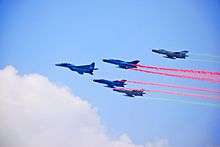
Bangladesh War of Independence
The modern history of Bangladesh military began its inception on the night of 25 March 1971 when the Pakistan military launched a brutal attack named Operation Searchlight. On 26 March[11] 1971, Major Ziaur Rahman, 2nd-in-Command of the 8th East Bengal Rgmt. and other Bengali officers organized a revolt and countered the Pakistan army units in Jessore, Chittagong, Comilla and other areas in East Pakistan. During the early morning hours of 26 March Sheikh Mujibur Rahman declared the Independence of Bangladesh as the interim head of the Provincial Bangladesh Government. On 27 March Major Ziaur Rahman broadcast the second declaration of Independence on behalf of Sheikh Mujibur Rahman from the captured Kalurghat radio station in Chittagong.[12] Hence, the Independence day of Bangladesh is 26 March.[13] On 4 April 1971 under the command and leadership of the commander-in-chief Colonel M. A. G. Osmani, the Bangladesh Forces began organization and creation with the title of Mukti Bahini. During the first Bangladesh Sector Commanders Conference[14] (held during 11–17 July 1971) Mukti Bahini were organized and formed for the ongoing Bangladesh Liberation war from Pakistan. It was significant in the sense that during this historic conference the Mukti Bahini field command structure, sector reorganization, reinforcement, appointment of field commanders and tactics of warfare were decided upon and carried out. This conference was presided over jointly by the then Prime Minister of Bangladesh, Tajuddin Ahmed,[15] and Colonel Muhammad Ataul Gani Osmani Commander in Chief of all Bangladesh Forces. During this conference M.A.G. Osmani was reinstated from retirement to active duty into the Armed Forces of Bangladesh as its senior most official, with the rank of Colonel reactivated. Principal participants of this conference were Principal Military Representative of Bangladesh Government-in-Exile at Chakulia Guerilla Training Camp (Bihar) Squadron Leader M. Hamidullah Khan, Mukti Bahini Commander Sector 1 Major Ziaur Rahman, Mukti Bahini Commander Sector 2 Major Khaled Mosharraf, Mukti Bahini Commander Sector 3 Major K M Shafiullah, Mukti Bahini Commander Sector 4 Major C R Datta, Major M. A. Jalil, Captain Rafiqul Islam, Lt. Col. Abdur Rab, Wing Commander Khademul Bashar, Major Najmul Haque, Major Mir Shawkat Ali. Lt. Col. Abdur Rab was appointed as Chief of Staff, Bangladesh Army.[16] Colonel Osmani unwillingly appointed Group Captain A. K. Khandker as Deputy Chief of Staff in place of Group Captain Muhammad Ghulam Tawab, whom Osmani wanted to appoint as his Deputy Commander-in-Chief. Bangladesh was divided into Eleven Sectors under Sector Commanders.[14] For better management of military operations each sector was divided into a combination of sub-sectors, commanded by a Sub-Sector Commander. The 10th Sector was kept under the direct command of the Commander in Chief and included the Naval Commandos as C-in-C’s special operations force. These commandos were later absorbed into the Bangladesh Navy.[17][18]
The Mukti Bahini received assistance from the Indian Government soon after the start of Bangladesh Liberation war.[19] The Soviet Union and the US were also drawn in the Cold War politics in the region. The US policy of the Nixon Administration, guided by then US National Security Advisor Henry Kissinger was courting Pakistan to open ties with China, hence could not support the Bangladeshi struggle for independence. However, Nixon's policy did supply emergency relief assistance to India and diplomatic support to Pakistan.[20][21]
On 21 November 1971, when the natural climate was dry and more adaptable and by which time the Bangladesh Forces had severely weakened the strength of the West Pakistan Forces through its guerilla operations, under a complicated politico-military scenario.[22][23] India-Pakistan war of 1971 breaks out and Indian troops enter Bangladesh allied with Mukti Bahini.[24] The Pakistani force were demoralized from constant attacks by the Mukti Bahini, on 16 December 1971 the Pakistani Military force in Bangladesh surrender to a joint force of Indian and Bangladesh forces.[25][26] Group Captain A. K. Khandker represented the Bangladeshi side at the signing of the surrender treaty.[27] K M Shafiullah, S Force commander, and a handful of others were also among the hundreds of local masses who surrounded the event from a distance. "No protocol was set on what they were supposed to do". A fact Shafiullah admitted himself. "We rushed to the Race Course from the airport. I was a member of Bangladesh delegation. But we were not sure what we were supposed to do. I was standing in front of the signing table. That's why I do not appear in any photographs. There was rejoicing all around. We put Niazi on a jeep and sent him away. That night I did not come across anyone." -Major General Shafiullah spoke to Kaushik Sankar Das.[28]
The Bangladesh Forces was organized for the War of Independence in 1971 under 11 (eleven) sectors and subsequently into three brigade size commands with ultimately only one being fully operational and organized, Z Force.
BDF HQQ's 8 Theatre Road, Calcutta, India.
Prime Minister: Mr. Tajuddin Ahmad
BD Forces C-in-C: Colonel Muhammad Ataul Gani Osmani (Appointed General 1972)
BD Forces Principal Military Representative: Chakulia Guerilla Training Camp (Bihar) – Squadron Leader M. Hamidullah Khan(Until June)
BD Forces Deputy C-in-C Group Captain Muhammad Ghulam Tawab (17 Dec 1971 ~ 7 April 1972)
BD Government Non-Combatant Staff :
BD Forces Military Secretary to C-in-C Major Chowdhury
BD Forces ADC to C-in-C Captain Noor
BD Forces PSO I to C-in-C – Administration and Personnel
BD Forces PSO II to C-in-C – Operations and Training
BD Forces Chief of Army Staff Lt. Col. M. A. Rab (HQ Tripura)
BD Forces Deputy Chief of Staff(Liaison) Group Captain A.K. Khandker (Kalyani Bldg.)
Medals and decorations
The following are the various gallantry, service and war medals of the Bangladesh Armed Forces.[29][30][31][32][33]
Gallantry awards

Service medals


Current deployments

Bangladesh has consistently made large contributions to United Nations peacekeeping operations. As of May 2007, Bangladesh had major deployments in Democratic Republic of Congo, Liberia, Lebanon, Sudan, Timor-Leste and Cote d'Ivoire.[34] With 10,736 troops deployed, it ranks first in personnel contributions to UN peacekeeping.[35] The government declined to participate in Iraq on a request from the United States. The deployment to Liberia began in October 2003 and has remained at a level of about 3200 who are participating in peacekeeping, charitable activities and infrastructure development.
Training
Officers are trained and educated for two and a half years at the Bangladesh Military Academy, Bhatiary, Bangladesh Naval Academy at Patenga, both located in Chittagong and Bangladesh Air Force Academy located in Jessore. For advance training during their career, officers are sent to Bangladesh Defence Services Command and Staff College at Mirpur, while senior officers attend the National Defense University for Armed Forces War Course. Many attend the Military Institute of Science and Technology while serving. Officers of the Army Medical Corps are recruited after graduation from civil medical colleges. They undergo basic military training at Bangladesh Military Academy followed by professional training in medical corps centre and Armed Forces Medical Institute. Recently cadets of Armed Forces Medical College also started joining the services directly.[36]
Ranks
Bangladesh military ranks, essentially corresponds to those used by the armed forces of the commonwealth nations.
There are three different systems of rank for commissioned officers of the Bangladesh Army, Bangladesh Navy and Bangladesh Air Force. The Para-military force Border Guards Bangladesh follows the same rank structure as the Bangladesh Army. Bangladesh Coast Guard follows the naval rank structure.
Organization
Regular forces
- Bangladesh Army (Bangladesh Sena Bahini)
- Bangladesh Navy (Bangladesh Nou-bahini)
- Bangladesh Air Force (Bangladesh Biman Bahini)
Para-military forces
- Bangladesh National Cadet Corps (BNCC)
- Border Guard Bangladesh (BGB)
- Bangladesh Coast Guard (BCG)
Civil forces and reserves
Specialized forces
- President Guard Regiment (PGR) – Bangabhaban (President's Office)
- Special Security Force (SSF) - Prime Minister's Office
- Para-Commando Brigade(The Cheetahs) - Under Command AHQ, Dhaka, Bangladesh Army
- Special Warfare Diving And Salvage (SWADS) – Bangladesh Navy
- 41 squadron airborne – Bangladesh Air Force
Military districts
- Savar Area Command
- Ghatail Area Command
- Bogra Area Command
- Rangpur Area Command
- Comilla Area Command
- Chittagong Area Command
- Ramu Area Command
- Jessore Area Command
- Sylhet Area Command
- Barisal Area Command
- Army Training and Doctrine Command
- Army Logistics Area
- HQ All Military Lands
- HQ Cantonment Boards
- HQ's of Bangladesh Army
- Armed Forces Division (AFD)
- 46 Independent Infantry Brigade
- 24 Independent Engineers Brigade
- 18 Engineers Brigade
- 6 Air Defence Brigade
- 14 Army Signal Brigade
- HQ, President's Guard Regiment
- Inter Services Selection Board (ISSB)
- HQ's Armed Forces Medical and Nursing Corps (AFMNC)
- Central Officer's Record Office (CORO)
- HQ's Armed Forces Recruiting Centre (AFRC)
- HQ's Cantonment Public Schools
- HQ's Armed Forces Library
- Armed Forces Institute of Pathology (AFIP)
- National Armed Forces Cemetery
Educational and training institutes
- Bangladesh Military Academy (BMA), Bhatiary, Chittagong
- School of Infantry and Tactics (SI&T), Jalalabad Cantonment, Sylhet.
- Defence Services Command and Staff College (DSC&SC), Mirpur Cantonment, Dhaka.
- National Defence College (NDC), Mirpur Cantonment, Dhaka.
- Military Institute of Science and Technology (MIST), Mirpur Cantonment, Dhaka.
- Armoured Corps Centre & School (ACC&S), Majira Cantonment, Bogra.[37]
- Engineer Centre and School of Military Engineering, Quadirabad Cantonment, Natore.
- Signal Training Centre and School, Jessore Cantonment, Jessore.
- Army Service Corp Centre & School, Jahanabad Cantonment, Khulna.
- Army Medical Corps Centre & School, Shaheed Salahuddin Cantonment, Ghatail, Tangail.
- Ordnance Corps Centre & School, Rajendrapur Cantonment, Gazipur
- Bangladesh Institute of Peace Support Operation Training (BIPSOT), Rajendrapur Cantonment, Gazipur.
- Electrical and Mechanical Engineering Centre and School, Saidpur Cantonment, Nilphamari.
- Corps of Military Police Centre and School, Shahid Salahuddin Cantonment, Ghatail, Tangail.
- Army School of Education and Administration, Shahid Salahuddin Cantonment, Ghatail, Tangail.
- Army School of Physical Training and Sports (ASPTS), Dhaka Cantonment, Dhaka.
- Army School of Music, Chittagong Cantonment, Chittagong.
- Armed Forces Medical College (AFMC), Dhaka Cantonment, Dhaka.
- Artillery Centre and School, Halishahar, Chittagong.
- School of Military Intelligence, Moynamoti Cantonment, Comilla.
- East Bengal Regimental Centre, Chittagong Cantonment, Chittagong.
- Bangladesh Infantry Regimental Centre, Rajshahi Cantonment, Rajshahi.
- Non Commissioned Officers Academy, Majira Cantonment, Bogra.[38]
- Bangladesh University Of Professionals(BUP), Mirpur Cantonment, Dhaka.
Training institutes of Bangladeshi Air Force
- Bangladesh Air Force Academy (BAFA), Jessore.
- Flying Instructors School (FIS), Bogra.
- Command and Staff Training Institute (CSTI), Dhaka.
- Flight Safety Institute (FSI), Dhaka.
- Officers' Training School (OTS), Jessore.
- Aero-Medical Institute (AMI), Dhaka.
- Fighter Controller Training Unit (FCTU), Dhaka.
- School of Physical Fitness (SOPF), Dhaka.
- Recruits Training School (RTS), Chittagong.
- Training Wing (TW), Chittagong.
- Mechanical Transport Driving School (MTDS), Shamsher Nagar.
Training Institutes of Bangladesh Navy
- Bangladesh Naval Academy (BNA), Chittagong.
- BNS Shaheed Moazzem, Kaptai, Rangamati Hill District, Chittagong. (For Sailor's Advanced Training)
- BNS ISA KHAN, Chittagong (Home of 13 Different Training Schools)
- BNS TITUMIR, Khulna (Home of New Entry Training School (NETS) and School of Logistics and Management (SOLAM))
- School of Maritime Warfare & Tactics, Chittagong Port.
Army Cantonments
Cantonments are where Bangladesh Army personnel work, train, and live.[39]
- Alikadam Cantonment (Bandarban)
- Bandarban Cantonment (Bandarban)
- Bangladesh Military Academy (Chittagong District)
- Bogra Cantonment (Bogra)
- Chittagong Cantonment (Chittagong)
- Comilla Cantonment (Comilla)
- Dhaka Cantonment (Dhaka)
- Dighinala Cantonment (Khagrachari)
- Halishahar Cantonment (Chittagong)
- Jahanabad Cantonment (Khulna)
- Jahangirabad Cantonment (Bogra)
- Jalalabad Cantonment (Sylhet)
- Jamuna Cantonment (Bhuapur, Tangail)
- Jessore Cantonment (Jessore)
- Kaptai Cantonment (Kaptai)
- Khagrachari Cantonment (Khagrachari)
- Kholahati Cantonment (Parbatipur, Dinajpur)
- Mirpur Cantonment (Mirpur)
- Mymensingh Cantonment (Mymensingh)
- Padma Cantonment (Munshiganj and Shariatpur)
- Postogola Cantonment (Dhaka)
- Qadirabad Cantonment (Natore)
- Rajendrapur Cantonment (Gazipur)
- Rajshahi Cantonment (Rajshahi)
- Ramu Cantonment (Ramu, Cox's Bazar)
- Rangamati Cantonment (Rangamati)
- Rangpur Cantonment (Rangpur)
- Saidpur Cantonment (Saidpur, Rangpur)
- Savar Cantonment (Savar)
- Shahid Salahuddin Cantonment (Ghatail, Tangail)
- Sheikh Hasina cantonment (Patuakhali)
Air Force bases
- BAF Base Bangabandhu (Dhaka)
- BAF Base Cox's Bazar (Cox's Bazar)
- BAF Base Khademul Bashar (Dhaka)
- BAF Base Matiur Rahman (Jessore)
- BAF Base Paharkanchanpur (Tangail)
- BAF Base Zahurul Haq (Chittagong)
Navy bases
- BNS Haji Mohshin (Dhaka)
- BNS Issa Khan (Chittagong)
- BNS Shaheed Moazzem (Rangamati)
- BNS Sheikh Hasina (Cox's Bazar)
- BNS Sher-e-Bangla (Patuakhali)
- BNS Titumir (Khulna)
- BNS Ulka (Chittagong)
- BNS Vatiary (Chittagong)
Gallery
.jpg) Humanitarian operation after Cyclone Sidr
Humanitarian operation after Cyclone Sidr_261.jpg) Bangladesh Army soldiers unload a shipment of bottled water for cyclone victims.
Bangladesh Army soldiers unload a shipment of bottled water for cyclone victims._(Special_Operations_Capable)_at_Barisal_Airfield.jpg) Bangladesh Army personnel unloading boxes of food for cyclone victims at Barisal
Bangladesh Army personnel unloading boxes of food for cyclone victims at Barisal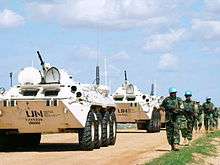 Bangladesh Army personnel and armoured personnel carrier in UN peacekeeping mission
Bangladesh Army personnel and armoured personnel carrier in UN peacekeeping mission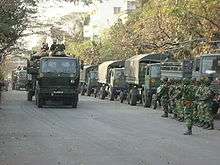 Army soldiers on active duty in Dhaka
Army soldiers on active duty in Dhaka Army personnel at Victory Day Parade 2012
Army personnel at Victory Day Parade 2012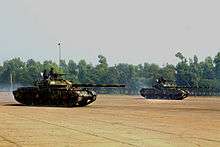 Bangladesh Army's main battle tanks at Victory Day Parade 2012
Bangladesh Army's main battle tanks at Victory Day Parade 2012 Bangladesh Army's Type-69II Mk2G main battle tank
Bangladesh Army's Type-69II Mk2G main battle tank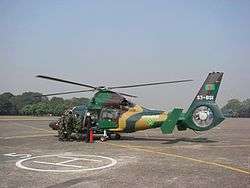 AS365 Dauphin helicopter of Bangladesh Army Aviation Group
AS365 Dauphin helicopter of Bangladesh Army Aviation Group BTR-80 armoured personnel carrier of Bangladesh Army
BTR-80 armoured personnel carrier of Bangladesh Army- Bangladesh navy frigate BNS Somudra Joy (F-28) at Pearl Harbor in 2013
.jpg) BNS Bangabandhu (F-25) guided missile frigate at sea.
BNS Bangabandhu (F-25) guided missile frigate at sea.- BNS Osman (F-18) guided missile frigate at sea
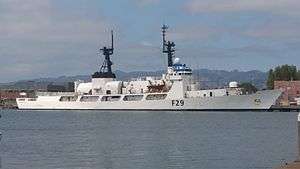 Bangladesh navy frigate BNS Somudra Avijan (F-29) at Alameda, California in 2015
Bangladesh navy frigate BNS Somudra Avijan (F-29) at Alameda, California in 2015.jpg) Bangladesh navy patrol ship BNS Sangu
Bangladesh navy patrol ship BNS Sangu%2C_right%2C_and_Sangu_(P-713).jpg)
%2C_debriefs_Bangladesh_Navy_Special_War.jpg)
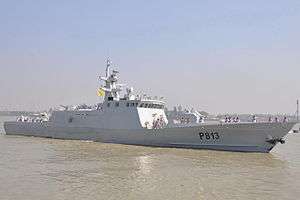 BNS Nirmul Durjoy-class patrol craft of Navy
BNS Nirmul Durjoy-class patrol craft of Navy Flypast of victory day, 2016 at National Parade Ground
Flypast of victory day, 2016 at National Parade Ground.jpg) Bangladesh Air Force Mikoyan MiG-29 multirole fighter aircraft
Bangladesh Air Force Mikoyan MiG-29 multirole fighter aircraft.jpg) Bangladesh Air Force Mig-29 rushes of for a short mission
Bangladesh Air Force Mig-29 rushes of for a short mission.jpg) Chengdu F-7 BG fighter aircraft of Bangladesh Air Force
Chengdu F-7 BG fighter aircraft of Bangladesh Air Force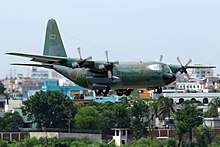 Lockheed C-130B military transport aircraft of Bangladesh Air Force
Lockheed C-130B military transport aircraft of Bangladesh Air Force.jpg) Bangladesh Air Force Antonov An-32 (converted bomber)
Bangladesh Air Force Antonov An-32 (converted bomber).jpg) Mil Mi-17 Hip helicopter of Bangladesh Air Force
Mil Mi-17 Hip helicopter of Bangladesh Air Force.jpg) Bangladesh Air Force Mil Mi-17 helicopter at UN Peacekeeping mission
Bangladesh Air Force Mil Mi-17 helicopter at UN Peacekeeping mission.jpg) Bangladesh Air Force aircraft during an exercise with US Air Force
Bangladesh Air Force aircraft during an exercise with US Air Force_paratroopers_descend_from_a_U.S._Air_Force_C-130_Hercules_aircraft_over_Bangladesh_during_exercise_Cope_South_14_Nov._12%2C_2013_131112-F-SI013-572.jpg) Bangladesh Air Force paratroopers descend from a C-130 aircraft
Bangladesh Air Force paratroopers descend from a C-130 aircraft
See also
References
- ↑ BanglaNews24.com. "সশস্ত্র বাহিনীর সদস্য ২ লাখ ৪ হাজার ৫৯৬ জন".
- ↑ "Chapter 6: Asia". The Military Balance (2015 ed.). International Institute for Strategic Studies. 17 February 2015. pp. 229–231. ISBN 9781857436426. Retrieved 13 April 2015.
- ↑ "Troop and police contributors". un.org. United Nations. Retrieved 22 June 2015.
- ↑ "6.3pc of budget proposed for defence". The New Age. 9 June 2018. Retrieved 8 June 2018.
- ↑ "Defence budget up Tk 3,329cr". The Independent. 8 June 2018. Retrieved 9 June 2018.
- ↑ "Ministry of Home Affairs | Government of the People's Republic of Bangladesh". mha.gov.bd. 1971-12-16. Retrieved 2013-05-21.
- ↑ "Hasina attends office at Armed Forces Division". The Daily Star. 2009-01-15. Retrieved 2017-10-03.
- ↑ "Lt Gen Mahfuzur new principal staff officer of Armed Forces Division". The Daily Star. 2016-02-03. Retrieved 2017-10-03.
- ↑ "Armed Forces Day today". The Daily Star. 2015-11-21. Retrieved 2017-10-03.
- ↑ "Significance of Armed Forces Day". The Daily Star. 2009-11-22. Retrieved 2017-10-03.
- ↑ Gupta, Jyoti Sen (1974). History of Freedom Movement in Bangladesh, 1943-1973: Some Involvement. Naya Prokash. pp. 325–326.
- ↑ "Declaration of Independence - Banglapedia". en.banglapedia.org. Retrieved 2017-10-03.
- ↑ "National Days - Banglapedia". en.banglapedia.org. Retrieved 2017-10-03.
- 1 2 Kawakita, Atsuyo. "Bangladesh War of Independence . The history of Bangladesh Independence War". www.bengalrenaissance.com. Retrieved 2017-10-03.
- ↑ "Remembering the Four Leaders". The Daily Star. 2013-11-08. Retrieved 2017-10-03.
- ↑ "::: Star Campus :::". archive.thedailystar.net. Retrieved 2017-10-03.
- ↑ "Naval Commandos in the Liberation War". The Daily Star. 2015-03-10. Retrieved 2017-10-03.
- ↑ "Operation Jackpot - Banglapedia". en.banglapedia.org. Retrieved 2017-10-03.
- ↑ "Unfinished agenda of the Liberation War". The Daily Star. 2016-03-26. Retrieved 2017-10-03.
- ↑ "Under the shadow of nuke cloud". The Daily Star. 2016-12-16. Retrieved 2017-10-03.
- ↑ "Nixon was advised to recognise Bangladesh". The Daily Star. 2016-03-24. Retrieved 2017-10-03.
- ↑ "War Calendar". The Daily Star. Retrieved 2017-10-03.
- ↑ "November 1, 1971". The Daily Star. 2014-12-14. Retrieved 2017-10-03.
- ↑ "The Tangail Landings: A signal for victory". The Daily Star. 2015-03-26. Retrieved 2017-10-03.
- ↑ "Gen Jacob's wit made Pak army surrender". The Daily Star. 2016-01-31. Retrieved 2017-10-03.
- ↑ "Stories". The Daily Star. Retrieved 2017-10-03.
- ↑ "Witnessing the surrender". The Daily Star. 2012-12-16. Retrieved 2017-10-03.
- ↑ "Journey to victory". The Daily Star. 16 December 2004. Archived from the original on 28 March 2005.
- ↑ "ODM of Bangladesh: Ribbon Chart". www.medals.org.uk.
- ↑ http://www.medals.org.uk/bangladesh/bangladesh-text.htm Text List of Ribbons
- ↑ http://www.jeanpaulleblanc.com/Bangladesh.htm Orders, Decorations and Medals of Bangladesh
- ↑ "Archived copy". Archived from the original on 1 July 2014. Retrieved 2014-07-14. Army Medal Lists: Official
- ↑ "Archived copy". Archived from the original on 22 December 2015. Retrieved 15 December 2015. Asian Medals: Bangladesh
- ↑ UN Mission's Summary detailed by Country, Monthly Summary of Contributors of Military and Civilian Police Personnel, Department of Peacekeeping Operations, United Nations, 2007-5-31
- ↑ Ranking of Military and Police Contributions to UN Operations, Monthly Summary of Contributors of Military and Civilian Police Personnel, Department of Peacekeeping Operations, United Nations, 2007-5-31
- ↑ "Bangladesharmy.org". Bangladesharmy.org. Archived from the original on 1 May 2013. Retrieved 21 May 2013.
- ↑ "Armoured Corps Center & School". www.army.mil.bd. Bangladesh Army. Archived from the original on 14 July 2014. Retrieved July 14, 2014.
- ↑ Singh, Ravi Shekhar Narain (2005). Asian Strategic and Military Perspective. New Delhi: Lancer Publishers. p. 25. ISBN 817062245X.
- ↑ "Cantonment Locations". www.joinbangladesharmy.mil.bd. Bangladesh Army. Archived from the original on 18 June 2015. Retrieved July 14, 2014.
External links
| Wikimedia Commons has media related to Military of Bangladesh. |